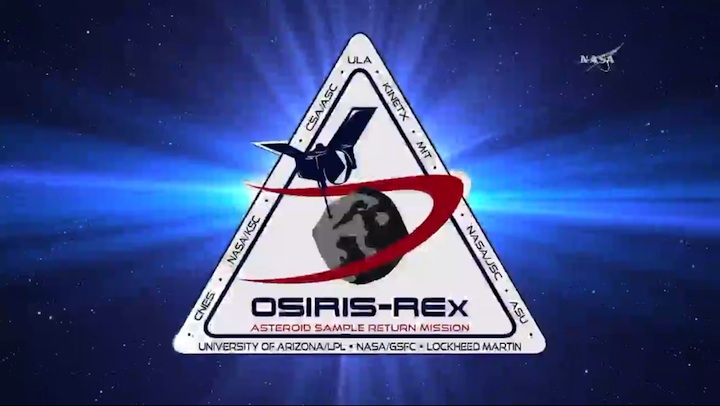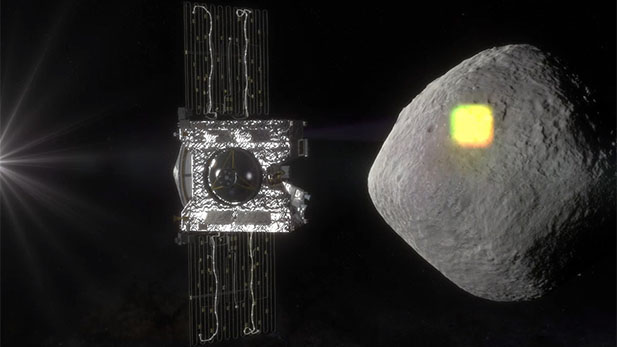
For space exploration missions, the best word you can hear is "nominal," meaning they are performing as they should.
The operation of the University of Arizona’s OSIRIS-REx mission to an asteroid is being described in superlative terms.
Three weeks into its seven-year mission to obtain and return a sample from an asteroid, OSIRIS-REx is on target.
“We have completely checked out our spacecraft and all of our science instruments, and everything is working perfectly," said the UA's Dante Lauretta, the mission's principal investigator.
Three cameras, built at the UA, were turned on last week and sent back 150 images of stars. Other instruments also were activated and all sent data back to the mission’s science headquarters in Tucson.
The asteroid sample will return to Earth in 2023.
Quelle: Arizona Public Media
---
Its science instruments have been powered on, and NASA’s OSIRIS-REx spacecraft continues on its journey to an asteroid. The spacecraft has passed its initial instrument check with flying colors as it speeds toward a 2018 rendezvous with the asteroid Bennu.
Last week NASA’s spacecraft designed to collect a sample of an asteroid ran the first check of its onboard instruments. Starting on Sept. 19, engineers controlling the Origins, Spectral Interpretation, Resource Identification, Security-Regolith Explorer (OSIRIS-REx) spacecraft powered on and operated the mission’s five science instruments and one of its navigational instruments. The data received from the checkout indicate that the spacecraft and its instruments are all healthy.
Instrument testing commenced with the OSIRIS-REx Camera Suite (OCAMS), provided by the University of Arizona. On Monday, OCAMS executed its power-on and test sequence with no issues. The cameras recorded a star field in Taurus north of the constellation Orion along with Orion’s bright red star Betelgeuse. The three OCAMS cameras performed flawlessly during the test.
On Monday and Wednesday, the OSIRIS-REx Laser Altimeter (OLA), contributed by the Canadian Space Agency, conducted its test sequences, which included a firing of its laser. All telemetry received from the OLA instrument was as expected.
On Tuesday, both the OSIRIS-REx Visible and Infrared Spectrometer (OVIRS), provided by NASA’s Goddard Space Flight Center, and the OSIRIS-REx Thermal Emissions Spectrometer (OTES), provided by Arizona State University, were separately powered on for tests. Data from both during the checkout showed that the instruments were healthy. The science measurements acquired from OTES exceeded the instrument’s performance requirements.
On Wednesday, the student experiment from MIT, the Regolith X-ray Imaging Spectrometer (REXIS), executed its functional test with no problems. And on Thursday, the Touch and Go Camera System (TAGCAMS) navigational camera was powered on and tested, and it operated as expected. As part of its checkout, TAGCAMS took an image of the spacecraft’s Sample Return Capsule.
The downlink of the test data continued through Sunday via the spacecraft’s low gain antenna (LGA), which transmitted at 40 kbps to NASA’s Deep Space Network.
Goddard Space Flight Center provides overall mission management, systems engineering and the safety and mission assurance for OSIRIS-REx. Dante Lauretta of the University of Arizona, Tucson, is the principal investigator. Lockheed Martin Space Systems in Denver built the spacecraft and is providing spacecraft flight operations. OSIRIS-REx is the third mission in NASA’s New Frontiers Program. NASA’s Marshall Space Flight Center in Huntsville, Alabama, manages the agency’s New Frontiers Program for its Science Mission Directorate in Washington.
Quelle: NASA
-
Update: 30.09.2016
.
Talking OSIRIS-REX With Science Team’s Dr. Humberto Campins & Former Astronaut Andrew Allen

Dr. Humberto Campins, a Professor of Physics and Astronomy at the University of Central Florida, holds his 4.6 billion year old carbonaceous chondrite meteorite sample, which was collected from northwest Africa. He works with NASA’s OSIRIS-REX mission imaging team, and will also assist in the creation of maps that will be used to select the mission’s sampling site on asteroid Bennu. Photo Credit: Sherry Valare / AmericaSpace
A United Launch Alliance (ULA) Atlas-V rocket thundered into the sky Sep 8, sending a spacecraft on its way to an asteroid and officially beginning the 7-year long Origins, Spectral Interpretation, Resource Identification, Security, Regolith Explorer (OSIRIS-REx) mission. OSIRIS-REx is currently speeding to asteroid Bennu, where it will go into orbit, find an ideal landing site, pick up a sample of regolith, then return that sample back to Earth for further study by scientists. It is hoped that the mission can help answer questions about how life on Earth formed, as well as what measures will need to be taken in the future to deflect an asteroid if ever one is found to be on a collision course.
Dr. Humberto Campins, a Professor of Physics and Astronomy at the University of Central Florida, recently gave an educational presentation about the science of the mission at the Orlando Science Center, and sat down with AmericaSpace to discuss his main contribution; working with the mission’s imaging team. He will also assist in the creation of maps that will be used to select the sampling site.
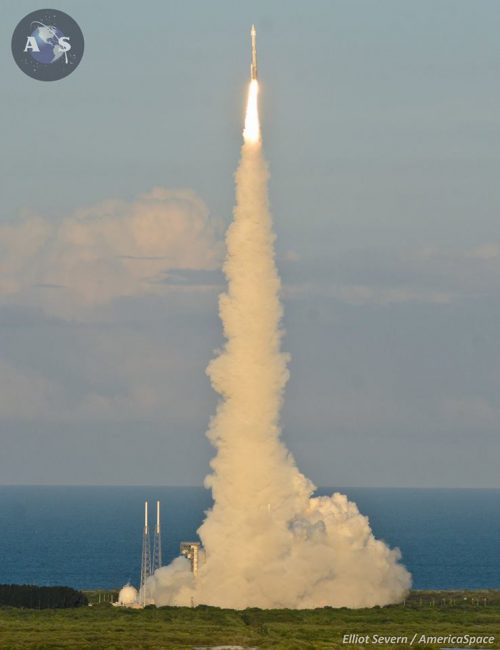
Under clear dusk skies, ULA’s workhorse Atlas-V thundered skyward from Florida’s Space Coast Sept. 8, flying in a rarely seen “411” configuration (one solid rocket booster) and punching through the golden sunset light at 7:05 p.m. EDT with OSIRIS-REX on a two-year trip to reach asteroid Bennu. Photo Credit: Elliot Severn / AmericaSpace
“OSIRIS-REx is an acronym that was actually put together by the principal investigator of the mission, Dante Lauretta. “Origins” means we will return a pristine sample of a carbonaceous asteroid, which we believe contains a lot of information about how the solar system formed”, said Dr. Campins in his opening remarks. ”
“Because this type of asteroid has not been subject to any heating, it has a lot of information that has been preserved. We’re going to bring back samples from an asteroid and be able to validate a lot of what we have been inferring about all the asteroids using ground based techniques, or even space based”, added Campins. We are going to identify resources that can be used for space exploration, including human exploration, of the solar system. Bennu is also a potentially hazardous asteroid. What that means is that it is not threatening earth now, but its orbit could change and it could become an impact hazard here within another 150 years or so. If we need to deflect this asteroid, this mission is going to help us understand how to do that a lot better.”
Asteroid Bennu was chosen as the target because of its proximity to Earth, its size, and its composition. Since asteroids contain so many natural resources – such as water, organics, and precious metals – studying them now is important since they could become crucial support systems for future manned and robotic missions.
Asteroids as primitive as Bennu are rich in carbon, and have not changed remarkably since their original formation 4 billion years ago. They contain organic molecules, volatiles, and amino acids; all of which are key ingredients that could have formed the foundation for the creation of life on Earth.
As Dr. Campins stated, “there are two main justifications for this mission. One of them is the practical one of Bennu being the most potentially hazardous asteroid. The other one is a scientific one, that it is going to tell us a lot about the origin of the solar system, and specifically, about the type of molecules that existed on Earth before life formed. The sample we are going to bring back from Bennu, is likely to tell us a lot about how life formed on Earth and how it may have formed elsewhere. It is also going to enable human exploration – to asteroids and to Mars, and it will help us to develop ways to mine asteroids for space exploration and even to bring some of those materials back.”
The OSIRIS-REx mission has five key science objectives.
- Return and analyze a sample of Bennu’s surface
- Map the asteroid
- Document the sample site
- Measure the orbit deviation caused by non-gravitational forces (the Yarkovsky effect)
- Compare observations at the asteroid to ground-based observations
So why a sample return mission? If we already have meteorites, most of which come from asteroids, why do we have to go out to an asteroid to pick up a sample?
According to Dr. Campins, “there have been two meteorite cases where we have observed the object enter the atmosphere, then recovered the meteorite. In both of those cases, we have determined that 99.9% of the mass that enters the atmosphere is lost. So, when we recover a meteorite, what we pick up is only 0.1% of what entered the atmosphere. Therefore, we don’t know what the 99.9% is. Bringing back samples will tell us – and chances are, the most interesting stuff is in there. Also, if we bring back samples, future scientists will invent new instruments and new techniques with which we can analyze them.”
Two months after the spacecraft gets close enough to Bennu and decreases its speed, a year-long detailed survey will commence so that sites for sample collection can be mapped out. After a site has been picked, the spacecraft’s Touch-And-Go Sample Acquisition Mechanism (TAGSAM) will extend out to the surface of the asteroid where it will make contact with it for five seconds. A sampler head at the end of the arm will shoot out a burst of pure nitrogen gas that will disrupt the regolith, pushing it into a chamber.

An artist’s rendering of OSIRIS-REx at asteroid 101955 Bennu. Its solar arrays will be configured in a “Y-wing” shape to avoid dust accumulation. Image Credit: NASA
During that five second pick-up, it is anticipated that the spacecraft will gather, at minimum, 60 grams of material, and at maximum, about 5 or 6 pounds. The outside of the TAGSAM will be outfitted with surface contact pads to collect fine-grained material during the time the sample collector is reaching the regolith. Up to three sampling attempts are possible since the instrument contains three bottles of the nitrogen gas.
Dr. Campins, elaborating on how this process will work, stated “the spacecraft will deploy its mechanical arm with the sampling mechanism at the end. We will approach the surface of the asteroid at minimal horizontal and vertical velocity. During the time we touch that surface for 5 seconds, there is a spring on that mechanical arm that will absorb some of the energy and then push the spacecraft away from the asteroid without having to fire the thrusters. We don’t want to fire those near the surface so we don’t kick up dust that could blind our cameras.”
In March of 2021, OSIRIS-REx will begin its two and a half year-long trip back to Earth to return its haul. The sample will be protected by a return capsule, which will protect it from heat, as it enters the atmosphere and lands back on the ground.
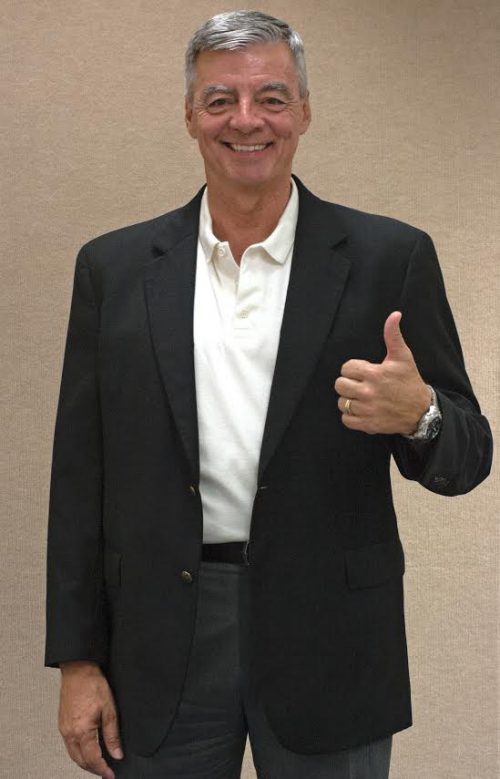
Andrew M. Allen, Shuttle Commander, three-time spaceflight veteran and currently Vice President and General Manager of the Test and Operations Contract (TOSC) at Kennedy Space Center. Photo Credit: Sherry Valare / AmericaSpace
As of September 15, 2016, the OSIRIS-REx spacecraft was performing perfectly and was located about 2 million miles away (3.2 million kilometers), cruising at approximately 12,300 miles per hour (19,800 kilometers per hour) relative to Earth. The star tracker navigational camera on-board proved that it was in fine working order when it snapped its very first image on September 12, 2016. The camera will continue to take pictures of the stars in order to compare them against an on-board catalog, so that the spacecraft navigation system can orient itself.
Also present at the Orlando Science Center, as a featured speaker, was Talking OSIRIS-REX With Science Team’s Dr. Humberto Campins & Astronaut Andrew AllenTalking OSIRIS-REX With Science Team’s Dr. Humberto Campins & Former Astronaut Andrew AllenTalking OSIRIS-REX With Science Team’s Dr. Humberto Campins & Former Astronaut Andrew Alle, Shuttle Commander and three-time spaceflight veteran. We caught up with him that evening for a question and answer session about his role in this mission. Allen is currently Vice President and General Manager of the Test and Operations Contract (TOSC) at Kennedy Space Center.
AS: What is your history as an astronaut?
- Allen: I was a pilot for two missions. The pilot is like the first officer. I was a shuttle commander for one mission – they trusted me enough to give me the keys!
AS: How could OSIRIS-REx help with future Mars missions?
- Allen: Well, there is a whole lot we don’t understand or know obviously. There is so much we can learn out there and missions like OSIRIS-REx will give us an opportunity to see what’s on some of these asteroids. There is this technology involved in this mission – you have to learn the answer to the question “How do we do this?”. It’s not that easy, and you’ll hear more about it from the experts, but it’s not a simple thing, like driving a car to your house. The spacecraft and the asteroid are both moving at very high speeds. You have to learn how to land correctly, then you have to figure out how to land to pick up your samples, and then get back to Earth. And then, this whole time, you have to figure out how to stay in communication, too. And it will be neat to see what they find out there. You know, we hypothesize everything when it comes to space. We just never know what we’re going to find.
AS: What is the work you do? Are you working with the OSIRIS-REx mission?
- Allen: The contract that I’m working on, the contract that I run, yes we did some work with OSIRIS-REx. The company I am with is Jacobs – they are the prime contractor. We do all the ground support to essentially, get everything off the pad at Kennedy Space Center. We call it ground operations. That includes getting all the pieces of equipment ready that support the equipment that shows up. We also do what we call processing – that means taking whatever the components are and putting them together. Then they are integrated, tested, checked-out, taken to the launch pad, and then you push that magic button that says “Go!”.
AS: How do you think the findings from OREX will help us once we do land on Mars?
- Allen: A lot of what OSIRIS-REx will do is give us some stepping stones for getting to Mars. What we may find in the samples of OSIRIS-REx (Hopefully ,we land in a good spot where we get some interesting samples!), for example, maybe a metal that we don’t know anything about, or an organism we know nothing about (Probably unlikely, but you never know!). You might even find some of the types of minerals and chemicals that we know exist or that we don’t think actually exist. You have to go back in time and think about what people felt like, back in Jamestown or Plymouth Rock – they didn’t really know what was over the hill, or what was around the bend in the river. We still even have a lot of stuff on Earth we don’t know anything about, but sometimes the science we learn from space will help us with that. Like imaging systems -MRI, CAT scan, x-rays, all those kinds of things – the more you learn about medicine and the human body, the more you realize what you don’t know. And space is…infinitely more than that.
In the past, samples of the moon (Apollo), a comet tail (Stardust), and solar wind (Genesis), have been collected and returned for study. Everything scientists learn from these missions contributes another piece to the greater puzzle of human space exploration, the origins of our existence, and how to protect the future of humanity here on Earth. Whether it is to learn about the building blocks of life or how to deflect an asteroid that is on a trajectory that intersects with our home planet, the importance of studying these bodies in our solar system cannot be understated.
As Dr. Campins reminded his audience, “About the impact of asteroids on Earth – as individuals, you do not need to lose any sleep over this because the chances of this happening during our lifetimes, are minimal. You do not count on winning the lottery to pay your next month’s rent or mortgage, therefore you should also not worry about an asteroid hitting us during your lifetime. However. Large impacts have occurred and unless civilization does something to prevent that next large impact, we will not continue to exist on Earth. As a civilization, this is a very important endeavor.” Proactively educating ourselves is critical to the preservation of the history of the human race and the future of the generations to follow.
Quelle: AS
-
Update: 29.12.2016
.
NASA's Origins, Spectral Interpretation, Resource Identification, and Security–Regolith Explorer, OSIRIS-REx, spacecraft executed its first deep space maneuver Dec. 28, 2016, putting it on course for an Earth flyby in September 2017. The team will continue to examine telemetry and tracking data as it becomes available at the current low data rate and will have more information in January.
Quelle: NASA
-
Update: 2.01.2017
.
Ted Forte — NASA ambassador for the OSIRIS-REx mission, much more
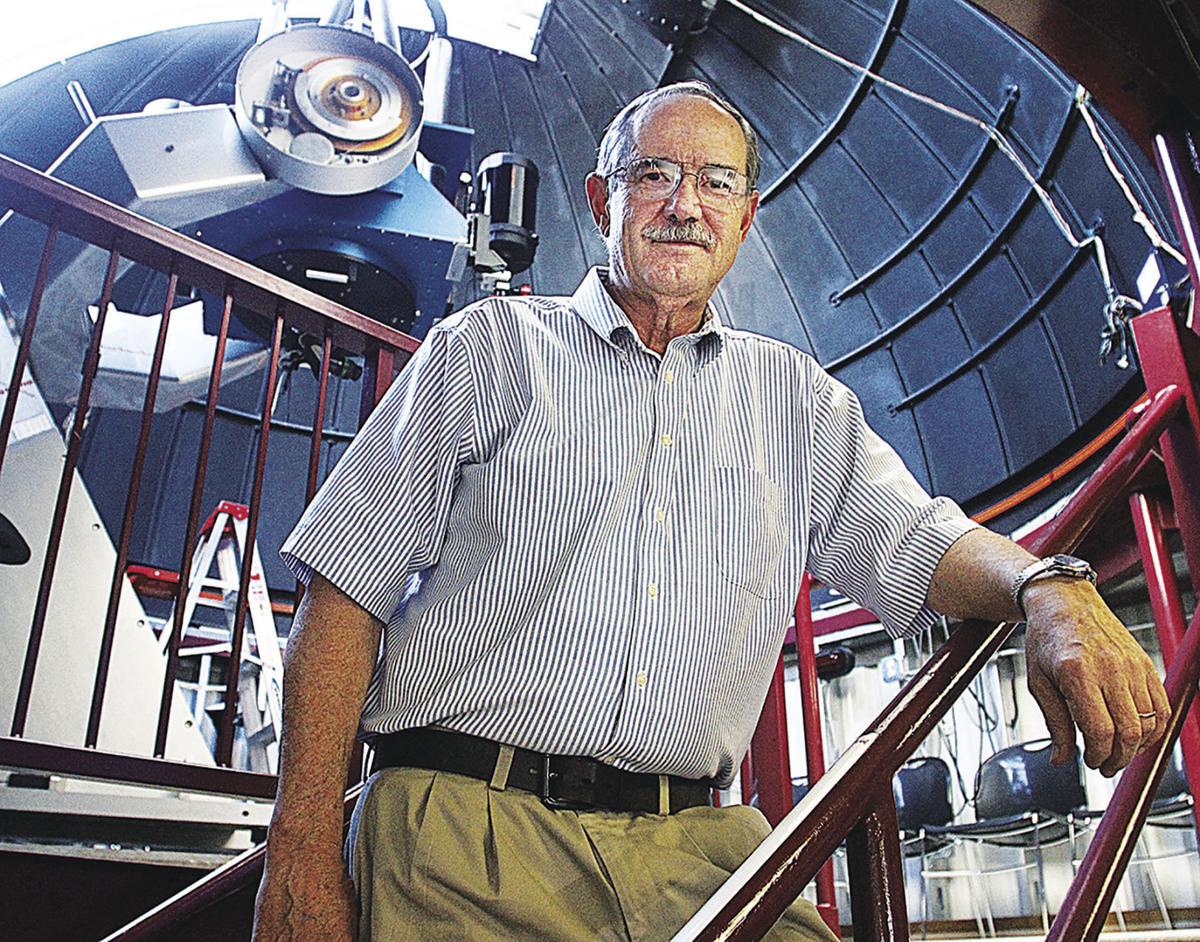
NASA Solar System Ambassador Ted Forte stands in the Patterson Observatory last week on the University of Arizona Sierra Vista campus. Forte is also a member of the Huachuca Astronomy Club.
SIERRA VISTA — It’s better than a movie script.
After orbiting the sun next year, OSIRIS-REx will soar into space using the gravitational field of Earth to catch up with an ancient asteroid, Bennu.
Once it gets close to this speeding rock, it will eventually bounce off the surface, collect a sample and return home to the friendly environs of Utah's West Desert.
For the next six years, this mission will capture the attention of southern Arizona and the nation, accomplishing a first in the amazing history of the National Aeronautics Space Administration. Located at the University of Arizona in Tucson, the OSIRIS-REx Science Processing and Operations Center is the heartbeat of a mission that began Sept. 8 with a launch from Cape Canaveral, Florida.
Cochise County’s connection is Ted Forte, a Sierra Vista resident who serves as a NASA solar system ambassador, and reports the progress and milestones of the mission.
Forte, a veteran member of the Huachuca Astronomy Club, said collecting a sample from the asteroid Bennu is expected to provide researchers with a glimpse into the origins of the celestial bodies that orbit the sun.
“(Bennu) is very primitive and is presumed to be made of primordial material unchanged since the formation of our solar system,” Forte said last week in an e-mail.
It’s expected OSIRIS-REx will enter orbit around Bennu sometime in August 2018.
“After studying the asteroid to select the perfect sample site, it will retrieve a sample of the surface material (regolith) in July 2020,” he said.
At a meeting earlier this year, HAC members had an opportunity to see a replica of the mechanism that will “vacuum” material from Bennu’s surface while the asteroid speeds through the solar system at 716 miles an hour.
“The Touch-And-Go Sample Acquisition Mechanism (TAGSAM) consists of a robotic arm with an attached sampler head,” Forte said. “OSIRIS-REx will obtain at least 60 grams (2.1 ounces) and up to 2 kilograms (4.4 pounds) of the sample.”
From that surface collection NASA researchers hope to gather enough insight to determine whether life on Earth began after an asteroid impact.
“We will be looking for organics and water in the returned sample,” Forte said. “Did asteroids like Bennu first bring the chemistry of life to Earth? OSIRIS-REx hopes to answer that question.”
Scientists will also be investigating what happens to Bennu when it orbits the sun.
“We will also be studying the Yarkovsky effect — the mechanism by which an asteroid’s orbit is changed by the sun heating the surface and then having the asteroid radiate that heat back into space as it rotates,” Forte said.
Understanding the precise effect the sun has on the path and speed of an asteroid will help NASA’s ability to deflect these objects if their path crosses Earth.
“Bennu, by the way, is a potentially hazardous asteroid that has a nonzero chance of impacting the Earth in the 22nd century,” Forte said.
OSIRIS-REx, which can attribute part of its name to the Egyptian god Osiris, is one of a number of missions that Forte speaks about in his role as a NASA solar system ambassador.
“I am also involved in relaying news and information about other NASA missions such as my very favorite mission: New Horizons that flew by Pluto in July 2015 and is now on its way to examine another Kuiper Belt object called 2014MU,” Forte said.
He speaks regularly to civic clubs and school groups, at no charge, about OSIRIS-REx and other NASA missions.
“Often, I can arrange to hold the event at Patterson or I can come to the organization’s facility or meeting location. I’m always available to visit schools,” Forte said.
Patterson Observatory is located on the University of Arizona South Campus in Sierra Vista, close to Cochise College. Monthly meetings of the HAC are often held at the facility, which boasts a large reflector telescope.
“I am both a NASA solar system ambassador, which is an all-encompassing generic outreach and information initiative that is managed out of the Jet Propulsion Laboratory (JPL) in Pasadena, Calif., and an OSIRIS-REx mission ambassador which is run out of the Lunar and Planetary Lab in Tucson,” Forte said.
NASA trains its ambassadors through a program of ongoing conferences over the Internet or by phone.
“We typically get to interact with mission scientists and/or the principal investigators of current missions so that we can stay as informed and current as possible,” Forte said.
Quelle: EASTERN ARIZONA COURIER
-
Update: 7.02.2017
.
NASA's OSIRIS-REx Spacecraft to Search for Trojan Asteroids Near Earth
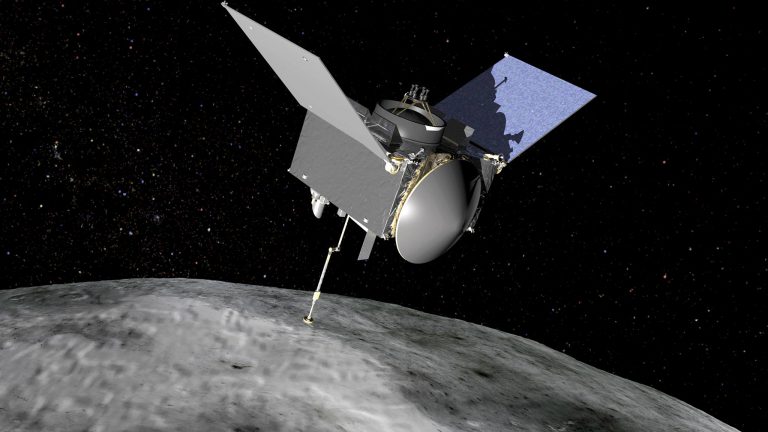
Artist’s depiction of OSIRIS-REx in orbit around Bennu. Currently, the spacecraft is searching for other Trojan asteroids near Earth. Image Credit: NASA
Asteroids are some of the most ancient objects in the Solar System, relics left over from the time when the planets first started forming and evolving. For this reason, scientists are very interested in them, since they can provide clues as to how this process occurred. Most asteroids orbit the Sun in a broad belt between Mars and Jupiter, but they can be found elsewhere in the Solar System as well. NASA’s OSIRIS-REx spacecraft is now en route to one of these asteroids, called Bennu, which it will study and then bring a sample back to Earth. While on the way there, however, OSIRIS-REx will also be searching for other asteroids, called Trojans. These have regular orbits which place them either just before or just behind a planet, including Earth. The spacecraft will be on the lookout for some of these Trojans near Earth this month as it travels toward Bennu.
This month, from Feb. 9-20, OSIRIS-REx will be in an ideal location to search for more of these objects. During those 12 days, the spacecraft will use its MapCam imager to scan the region where Trojans are most likely to be found.
“The Earth-Trojan asteroid search provides a substantial advantage to the OSIRIS-REx mission,” said OSIRIS-REx Principal Investigator Dante Lauretta of the University of Arizona, Tucson. “Not only do we have the opportunity to discover new members of an asteroid class, but more importantly, we are practicing critical mission operations in advance of our arrival at Bennu, which ultimately reduces mission risk.”
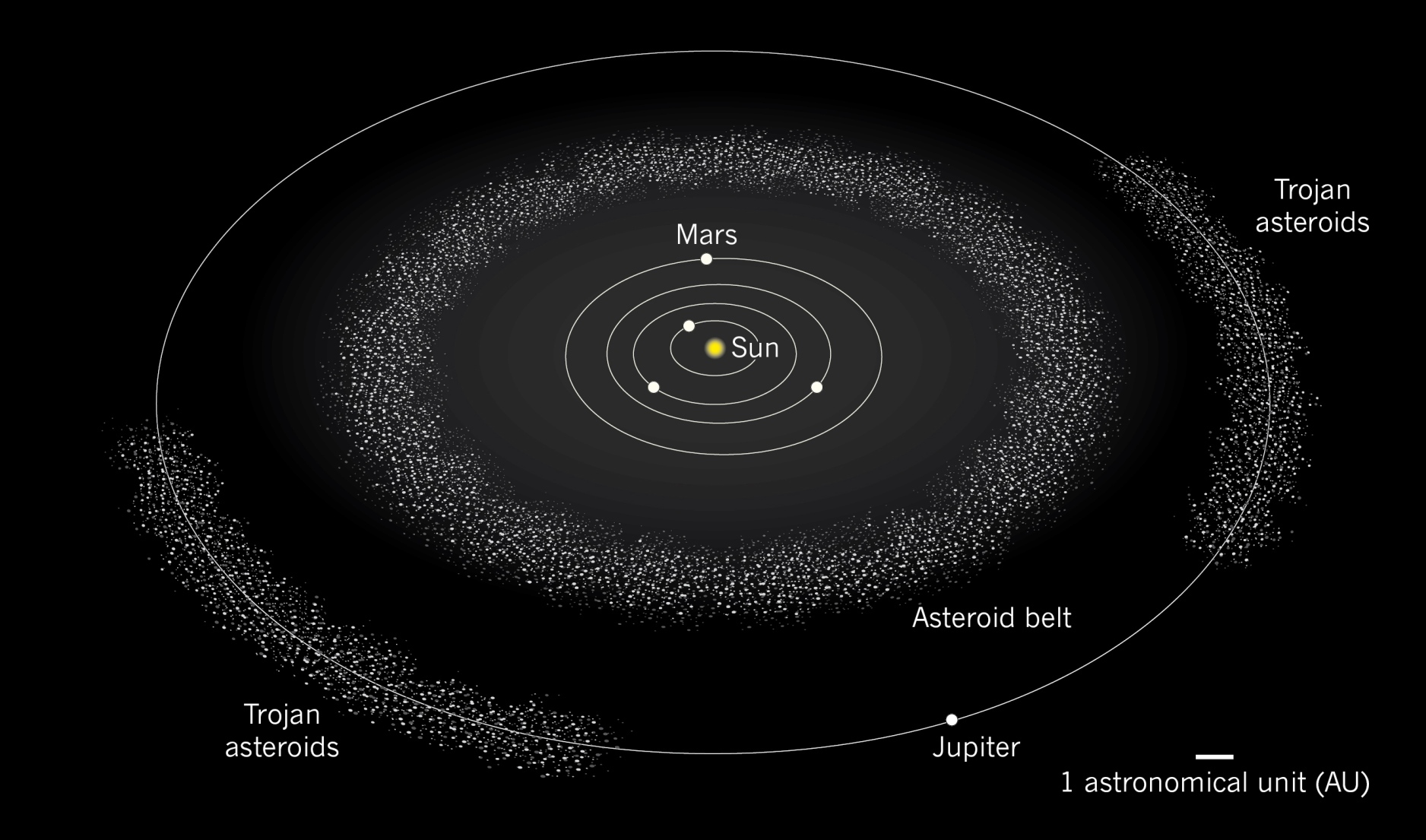
Diagram showing the Trojan asteroids in the same orbit of Jupiter. So far only one has been found in Earth’s orbit, but scientists think there are more. Image Credit: Nature
The same instruments will also be used at Bennu, so this presents a good opportunity to test them out beforehand.
Trojans are known to accompany six planets – Venus, Earth, Mars, Jupiter, Uranus and Neptune. They remain in stable orbits either leading or following the planet in its own orbit, 60 degrees before or after the planet. Since the orbits are stable, there is no fear of collision with the planets. So far, only one Earth Trojan asteroid has been found – 2010 TK7 – found in 2010 by NASA’s NEOWISE project. Scientists think there are more however, since they are difficult to detect due to appearing close to the Sun as seen from Earth. Jupiter, for example, has 6,000 known Trojans. Discovering more of them near Earth would be an exciting find for planetary scientists.
“That would be the most fascinating thing we could discover,” said Lauretta.
OSIRIS-REx will also be on the lookout for any small moons circling Bennu. Ground-based telescopes so far have not found any larger than about 65 feet across, which is the smallest they could detect.
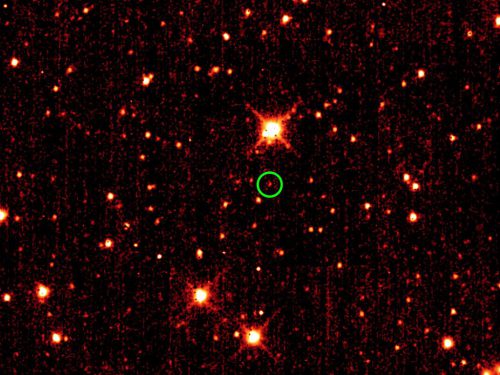
So far only one Trojan asteroid is known about near Earth, 2010 TK7 (circled), but OSIRIS-REx will search for others this month. Photo Credit: NASA/Jet Propulsion Lab-Caltech/UCLA
“That’s a substantial object and we’d obviously want to know that it’s there and plan our operations accordingly,” Lauretta said.
OSIRIS-REx is the first U.S. mission to travel to an asteroid and then return a sample back to Earth. It will approach Bennu, a carbonaceous asteroid, in August 2018 and start surveying the asteroid in October, which will last over one year. The four phases of the survey include:
- Preliminary Survey searches for asteroid plumes and natural satellites, and also measures the Yarkovsky acceleration of Bennu.
- Orbital A allows the Flight Dynamics Team to transition from star-based navigation to landmark-based navigation using images of Bennu’s surface.
- In Detailed Survey, several instruments work together to map Bennu and determine its global spectral, thermal, and geological properties.
- Orbital B continues to map Bennu at higher resolutions, with a focus on candidate sample sites. At the end of Orbital B a sample site will be selected.
Then, in July 2020, the spacecraft will attempt to take a sample from the asteroid’s surface material, which it will then return to Earth, in September 2023.
The main objectives of the mission include:
- Return and analyze a sample of Bennu’s surface
- Map the asteroid
- Document the sample site
- Measure the orbit deviation caused by non-gravitational forces (the Yarkovsky effect)
- Compare observations at the asteroid to ground-based observations
OSIRIS-REx was launched on Sept. 8, 2016. According to Jim Green, director of the agency’s Planetary Science Division, “One of the amazing things about OSIRIS-REx is that it addresses all of the science goals that planetary science has at NASA: how the Solar System works, how it formed, how it informs our understanding of life in Solar System and elsewhere, and how we can understand the resources and hazards of asteroids and better characterize those.”
There are three main reasons why Bennu was chosen for a sample-return mission:
- Proximity to Earth
The closest asteroids to Earth are Near-Earth Objects (NEOs). As their name suggests, NEOs are objects that orbit within 1.3 AU of the Sun. For a sample return mission like OSIRIS-REx, the easiest asteroids to visit will travel between 1.6 AU and 0.8 AU. The ideal asteroid will have an Earth-like orbit, with low eccentricity, and inclination. At the time of asteroid selection in 2008, there were over 7000 known NEOs, but only 192 had orbits that met these criteria. - Size
Asteroids with small diameters rotate more rapidly than those with large diameters. With a diameter less than 200 meters, an asteroid spins so rapidly that the loose material on its surface (regolith) can be ejected from it. The ideal asteroid will have a diameter larger than 200 m so that a spacecraft can safely come into contact with it. This size requirement reduced the number of candidate asteroids from 192 to 26. - Composition
Asteroids have been divided into different types based on their chemical composition. The most primitive asteroids are carbon-rich and have not significantly changed since they formed nearly 4 billion years ago. These asteroids contain organic molecules, volatiles, and amino acids that may have been the precursors to life on Earth. Of the 26 asteroids left on the list, only 12 had a known composition, and only five were primitive and carbon-rich.
Another reason for the interest in Bennu is a concern also shared for other near-Earth asteroids – unlike Trojans, Bennu is in an orbit which could possibly cause it to collide with Earth sometime in the 22nd century. OSIRIS-Rex will study Bennu’s physical and chemical properties, which would be critical to know in case an impact mitigation mission was necessary.
On Jan. 17, it was announced that OSIRIS-REx had successfully completed its first Deep Space Maneuver (DSM-1) (Dec. 28, 2016). This engine burn prepares the spacecraft for an Earth gravity assist this coming fall as it continues its two-year journey to Bennu. The burn resulted in a 964 miles per hour (431 meters per second) change in the spacecraft’s velocity, utilizing 780 pounds (354 kilograms) of fuel.
“DSM-1 was our first major trajectory change and first use of the main engines, so it’s good to have that under our belts and be on a safe trajectory to Bennu,” said Arlin Bartels, deputy project manager at NASA’s Goddard Space Flight Center in Greenbelt, Maryland.
Before the launch, artists and other space enthusiasts were invited to submit artwork to be included onboard the spacecraft.
“We’re thrilled to be able to share the OSIRIS-REx adventure with people across the Earth, to Bennu and back,” said Lauretta. “It’s a great opportunity for people to get engaged with the mission early and join us as we prepare for launch.”
As also noted by Bill Nye, “You’ll be part of humankind’s exploration of the Solar System – How cool is that?”
See also Lauretta’s latest blog entry for more information about the Trojans. The OSIRIS-REx mission is managed by NASA’s Goddard Space Flight Center and the spacecraft was built by Lockheed Martin Space Systems. More information about OSIRIS-REx mission is available on the mission website.
Quelle: AS
-
Update: 10.02.2017
.
A NASA spacecraft begins its search Thursday for an enigmatic class of near-Earth objects known as Earth-Trojan asteroids. OSIRIS-REx, currently on a two-year outbound journey to the asteroid Bennu, will spend almost two weeks searching for evidence of these small bodies.
Trojan asteroids are trapped in stable gravity wells, called Lagrange points, which precede or follow a planet. OSIRIS-REx is currently traveling through Earth's fourth Lagrange point, which is located 60 degrees ahead in Earth's orbit around the sun, about 90 million miles (150 million kilometers) from our planet. The mission team will use this opportunity to take multiple images of the area with the spacecraft’s MapCam camera in the hope of identifying Earth-Trojan asteroids in the region.


